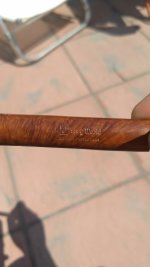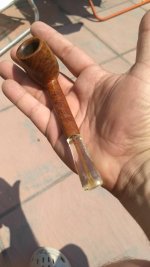Lets See Your High End Collections
- Thread starter cigrmaster
- Start date
You are using an out of date browser. It may not display this or other websites correctly.
You should upgrade or use an alternative browser.
You should upgrade or use an alternative browser.
SmokingPipes.com Updates
Watch for Updates Twice a Week
I was a member of that group. We could post our pipes in a sort of personal collection library as I recall where other sewer dwellers could view. It was fun.I think this clearly makes my point that PM has the best collections of high end pipes on the internet.
There used to be a private site invitation only called the Common Sewers. It was one of the many rooms that was part of smokersforum.uk.
The Common Serves was a site where all high end pipes could be discussed without having to apologize for having that kind of money invested in pipes. I was a piker to those guys. My Rad Davis and other American artisan pipes smoked great and not once was I felt out.
There were some amazing pieces of work that you would never see anywhere else. There were a lot of heavy hitters from the pipe world and the conversations were very cool. I learned much of what I know now from those guys just as I learned a bunch of cool stuff from this thread.
Interesting post.
The obvious conclusion is that High End means different things to different members of this forum.
The obvious conclusion is that High End means different things to different members of this forum.
Is this shape specific to that era or was it made for a long time?I just scored an 1892 Patent Pete. Most I’ve ever spent on a single pipe. But it was a Grail move. I can’t wait until it arrives and I put the match to it.
View attachment 165626View attachment 165627View attachment 165628
It was made for a long time. The verifiable year is “high end”Is this shape specific to that era or was it made for a long time?
Yep, as usualInteresting post.
The obvious conclusion is that High End means different things to different members of this forum.
Not easy to keep a thread "pure and clear".
High end = denoting the most expensive of a range of products.
But that is only Oxford Languages and obviously the definition does not apply to pipes .
Yeah, but Rome wasn't built in a day@ashdigger : Didn't the 'Almighty' do the whole world 'thing' in seven days or something? Just saying!
Thanks. I asked because I have that pipe. I don't think mine is that old and it definitely doesn't have a silver ring.It was made for a long time. The verifiable year is “high end”
It takes me a month to paint one door .Yeah, but Rome wasn't built in a day
Whether in pipes or any other good produced by man, the return on each dollar invested decreases with the amount. That is to say that the difference between a 50 and 100 dollar pipe will be very noticeable (a neophyte with some knowledge of manufacturing will be able to tell which is the best even if he has never seen a pipe before) the difference between a 100 and a 200 It will be noticeable but perhaps less and as the price goes up the differences will be more subtle. It should also be borne in mind that in a visual post there are many features that are not appreciated, such as the perfect mouthpiece, the drilling or the weight of the pipe, to give an example.Is there such a thing as a 2 to 8 grand (new unused) pipe as the OP has stated? I can’t imagine anyone paying more than a grand or two. That and every pipe in this thread doesn’t look worth over a grand (to me of course). Yeah they have nice grain but still…
Of course, I may just not have an eye for such things. But let’s admit it is a visual thing exclusively. Performance is irrelevant when 8/10 run of the mill pipes smoke just fine.
The only guy that comes close to being able to justify $1000+ is the guy with what was the most costly pipe 200 years ago. But even that…looks like any old pipe.
I’m not knocking you guys but I was expecting to see pipes with more precious metals, bedazzled with gemstones and crazier shapes.
This is not luxury or high end, it is simply ostentatious wealth. It is a regular PVC helmet whose only difference is that it has HERMES written on it.In reply to your post, would seem there is a luxury market for anything.
View attachment 166033
It is interesting to consider this value curve. As @Briar Lee pointed out in previous pages, luxury is somewhat contrived. Often by the manufacturer, but also by the consumer(s) of the product. I hope that my short response to his prior statement does not offend - upon re-reading I noticed that my hasty response comes off snippy, if not snarky, and I meant no affront or offense in my reply. My thought was more along the lines that this concept of high-end can end up being so ill-defined when talking to a group of collectors that assign value very differently, but there was an attempt at defining that range for this discussion. Some place value on age, rarity, or representation of a specific era. Others place value on the maker, artisan, or other branding along with the “weight” those particular names and stamps carry. Lots of discussion always comes up when the price tag is considered, as we all feel a little differently about our own value curve definitions.Whether in pipes or any other good produced by man, the return on each dollar invested decreases with the amount. That is to say that the difference between a 50 and 100 dollar pipe will be very noticeable (a neophyte with some knowledge of manufacturing will be able to tell which is the best even if he has never seen a pipe before) the difference between a 100 and a 200 It will be noticeable but perhaps less and as the price goes up the differences will be more subtle. It should also be borne in mind that in a visual post there are many features that are not appreciated, such as the perfect mouthpiece, the drilling or the weight of the pipe, to give an example.
I also agree that there is a whole host of other attributes that cannot be communicated via photos or even long-winded texts, and each of these attributes have their own sliding scale of importance and subtlety that only personal experience can define preference for. These factors all contribute to an individual’s assessment of value or worth, and as that is further defined for each of us, we can decide how much of our disposable income can be parted with in exchange for these tiny details that may not be important or even perceptible to others. Some of these factors include construction (and the myriad ways to change the experience and performance of the pipe, whether in style, shape, or the “engineering” of the pipe), balance, weight, grain orientation. Possibly one of the most common and significant factors is personal connection, whether to the pipe through use and familiarity and experience, or to the maker, or a connection that is important because of the manner in which the pipe came to be in a person’s collection (gift, inheritance, trade, souvenir purchase, etc). All of these make the “magic” for the smoker.






















